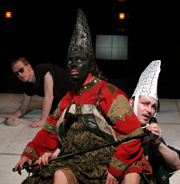
Paulanne Simmons
The Emperor Jones…Again
 |
| Scott Shepherd, Kate Valk, Ari Fliakos in "The Emperor Jones. Photo by Paula Cort. |
"The Emperor Jones"
Directed by Elizabeth LeCompte
The Wooster Group
St. Ann's Warehouse
38 Water St. in DUMBO, Brooklyn
Opened March 1, 2006
Wed.-Sun. 8 p.m.
$25 Wed., $37.50 Thurs.-Sun. (718) 254.8779 or www.ticketweb.com
Closes April 2, 2006
Reviewed by Paulanne Simmons March 10, 2006
In 1920, when the Provincetown Players cast a black man to play the African American Brutus Jones in Eugene O'Neill's "The Emperor Jones," it was a courageous and revolutionary step. Then in 1998 The Wooster Group made a complete about face and cast a white woman in the role.
This alone would have again been a brave, politically incorrect step. But it was only the beginning. The woman wore blackface and spoke her lines in the idiom of those notorious minstrel shows that were popular well into the twentieth century. The resulting play is not so much about black men as the white man's image of black men.
This is the production now onstage at St. Ann's Warehouse in Brooklyn.
Kate Valk reprises the role of Brutus Jones, the black railroad porter who has escaped from prison and landed on a West Indian island where he has exploited the natives and installed himself as emperor. She declaims in raucous, melodramatic tones and enhances her performances with rolling eyes and exaggerated gestures. Ari Fliakas and Scott Shepherd take over the role (on alternate nights) of the wheedling Cockney trader, Smithers, originally played by Willem Dafoe. Both Smithers and Jones speak into microphones that amplify and distort their voices.
If director Elizabeth LeCompte had stopped here, the production would have been a brilliant and revelatory interpretation of O'Neill's work. After all, the play is written in dialect and depends upon a certain (mis)conception of blacks in America.
But LeCompte made the decision to push the theatrical references even further. She placed video screens that have no apparent purpose on the stage. She dressed Valk and Fliakos/Shepherd as Samurai warriors. She has them perform some kind of slow motion disco dance. She experiments with erratic lighting and sound.
There may be some reason for introducing all these elements into O'Neill's story of a man who confronts his personal past and the past of his people as he flees enraged natives. But if there is, it has little to do with anything one can imagine the playwright had in mind. This in itself is not necessarily bad. But there's something intellectually pretentious about a production that takes a play, which is already expressionistic, and turns it into exercise in abstraction.
There's no doubt this Emperor Jones has a compelling intensity. But after a while the unvarying pitch becomes monotonous. One yearns to cry out, "enough already." As that is impossible, the only alternative is to block out the noise and let the mind wander.
The Wooster Group's The Emperor Jones is the kind of show
the critics love to love. The question is what does it do for the average
theatergoer who just wants to be entertained and enlightened.
| museums | NYTW mail | recordings | coupons | publications | classified |
